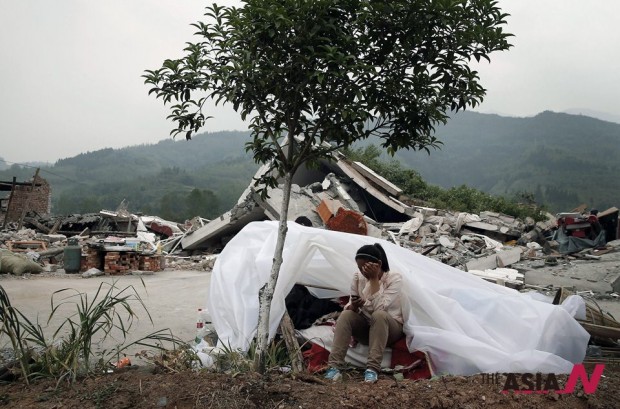Aftershocks pose threat of secondary disasters in quake-hit Sichuan

A child sits at a makeshift tent in front of homes destroyed by Saturday's earthquake in Longmen village in Lushan county of southwest China's Sichuan province on Sunday, April 21, 2013. Saturday's earthquake in Sichuan province killed at least 186 people, injured more than 11,000 and left nearly two dozen missing, mostly in the rural communities around Ya'an city, along the same fault line where a devastating quake to the north killed more than 90,000 people in Sichuan and neighboring areas five years ago in one of China's worst natural disasters. <AP Photo>
Secondary disasters such as mudslides and dam-related crises may occur in the days or even months after earthquake of April 20, threatening the safety of residents and rescuers, geologists warn.
China’s authorities issued warnings amid potential for mudslides, damage to dams and nuclear plants in earthquake-hit areas, according to the official Xinhua News Agency.
Fan Xiao, chief engineer at the Sichuan Geology and Mineral Bureau in Chengdu, said the banks along the Qingyi River, in one of the most geologically unstable regions of the province, had taken a big hit.
Known for its high mountains and deep valleys, the area was already unstable before the earthquake, with villages and roads sitting almost in the path of potential landslides, Fan said. And shockwaves from the earthquake could profoundly increase structural instability in the region.
“Residents and rescuers must be highly alert to the dangers of mudslides, especially after rain,” he said. “There will be lots of rain in the coming months.”
Like all major rivers in Sichuan, the Qingyi has been heavily dammed by hydropower projects. Though none collapsed during the quake, the biggest threat to the dams’ structural integrity will come during the summer flood season, Fan said.
Yang Yong , an independent geologist based in Chengdu who is familiar with hydropower projects in the region, told The Beijing News that he was worried because of the large number of dams in the quake zone.
“The closest dam was just 10 kilometres from the epicentre,” he was quoted as saying. “Communications and transportation were both cut off. We don’t know the situation there.”
The Ministry of Water Resources said on its website that 14 large dams affected by the shockwaves remained stable, but two medium-sized dams were damaged. Authorities did not give the extent of the damage, or the locations or names of the dams. Additionally, 52 small dams were damaged, and states of emergency were issued for five of them, resulting in downstream residents being evacuated.
More than 3,000 hydropower engineers, workers and military personnel had been sent to examine all dams in the region and carry out repairs, it said.
The Ministry of Land and Resources said more than 10 landslides had occurred on roads deemed critical to search-and-rescue work, while monitors at five possible mudslide sites in Yaan city sounded alerts.
The ministry issued a red alert for mudslides and landslides in towns in Lushan county. As of April 22, the quake zone had experienced 1,642 aftershocks – the strongest with a magnitude of 5.4.
The China Meteorological Administration warned that rain was expected in the quake zone in the three days following the earthquake, increasing the risk of secondary disasters.
Sichuan is also known for its nuclear facilities, many of which are for military purposes. The China National Nuclear Power Corporation announced on its website that its nine nuclear facilities in Sichuan experienced various levels of shockwaves at the weekend, prompting safety checks. There had been no reports of leaking pipes or collapsed buildings at the facilities.
Authorities mobilized thousands of soldiers and rescuers to earthquake-ravaged Sichuan Province. Rescuers struggled to reach a remote, rural corner of southwestern China as the toll of the dead and missing from the country’s worst earthquake in three years climbed to at least 213 with than 11,000 injuries.
The 6.6 magnitude quake struck in Lushan county the southwestern province of Sichuan, close to where a devastating 7.9 quake hit in May 2008, killing 70,000.
Most of the deaths were concentrated in Lushan, a short drive up the valley from Ya’an, but rescuers’ progress was hampered by the narrowness of the road and landslides, as well as government controls restricting access to avoid traffic jams.
Mountain roads blocked by rocks and landslides hampered rescue efforts to reach every village and household affected by the quake — measured at magnitude-6.6 by the U.S. Geological Survey — that struck Saturday morning in the same region where a 2008 quake took nearly 90,000 lives. <Compiled from Xinhua and other news reports>
























































